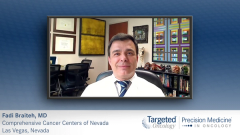
Later Lines of Therapy for GIST Treatments
Implications for treating patients with gastrointestinal stromal tumors (GISTs) in the later lines of therapy after switching from 1 treatment to another.
Brian Van Tine, MD, PhD: There was testing within a lot of these trials looking at serum biomarkers against escape, against response. When that gets reported, it will also help us better manage patients. There’s a lot more to come in this space.
We brought in 2 new FDA-approved drugs that are directly just for third indications, indirectly for GIST [gastrointestinal stromal tumor]. We know sequencing matters. Knowing what’s going on matters. Oncologists want to do the best by their patients, and this becomes much more complicated. I find that with a subset of these patients, this is much more complicated than it was when we had imatinib, sunitinib, and regorafenib and then whatever we could get paid for. Wouldn’t you agree?
Fadi Braiteh, MD: I agree, and complex and complicated in a good way. This is bringing more options to the patients. It just continues to fascinate us. As I mentioned earlier, the model of precision oncology that we push for in the treatment for solid tumors, in general, is something that in the liquid malignancies or hematologic malignancies proceeded us for a long time. With cytogenetics and phenotypes under the optical microscope, we were able to have those distinctions and do those studies earlier. At the end of the day, they look all the same under the optical microscope. Hopefully, as you mentioned sampling from circulating tumor DNA, we can try to switch quickly.
Another promise in some of these studies in the future—in solid tumors in general, and even GIST in particular—the way we assess response may be moving away from waiting 2, 3 months to repeating imaging. Yes, GIST was the first model of turning off the lighting of a PET [positron emission tomography] or CT scan within 24 hours because it’s working. We hope very early imaging will give us an answer, but we may evolve. Again, I’m saying you draw conclusions too early. Based on circulating tumor DNA or proteomics, we may say, “You know what? This drug is not promising, in terms of working.” Of course, we need the clinical data to prove it. Because what’s happening is the list of drugs for any tumor is increasing. Across other diseases we’re having more patients’ quality of life and performance decline because of the growth of the disease before we had the time to sequence all our drugs. We need a smarter way and smarter means with assessment, interrogation of the patient’s body, to really direct whether we can switch therapy. I feel this is becoming the future, although this is an unmet need and we will wait to have that technology.
Brian Van Tine, MD, PhD: What is your personal fifth-line therapy for GIST?
Fadi Braiteh, MD: With ripretinib making it as the fourth-line approach—let’s say it’s falling there—it’s 1 of 2 things. Preferably, of course, is a phase 1 trial or a specific GIST trial, which I don’t have but we usually have phase 1 trials because I direct a phase 1 program. Even if a trial is agnostic, we try to match with a molecular pathway to see if anything is available. If not, we may start to adventure into these other multi-TKIs [tyrosine kinase inhibitors]. There are data in published series’ with pazopanib-nilotinib. I would not necessarily go to sorafenib, but I have, in the past, used something off-label. If the patient has a BRAF V600E mutation, you could use 1 of the many BRAF inhibitors. I’ve not used BRAF with MEK inhibitors or BRAF inhibitors in development.
Brian Van Tine, MD, PhD: Based on the new European data, I could go with cabozantinib. A nice series just published revealing that cabozantinib is active, which is unexpected. Crizotinib, not so much. Cabozantinib seems to be an active drug. My real question is, I don’t know where to put it. We haven’t actually sequenced it in with these beautiful new FDA-approved molecules. But after that, dasatinib-nilotinib-sorafenib becomes a challenge. Phase 1 trials, once you’re at that level, make a lot of sense. So I am in complete agreement with you.
Fadi Braiteh, MD: I caution my colleagues to keep track of what’s happening, and not to venture toward a costly drug that’s unlikely to be paid or covered by the payer, and even to drag a patient and cash pay a consult with a tertiary center. Sometimes you don’t have to have the patient consult. Sometimes it can be a very casual personal opinion. That’s why we like email—I’m sure you get tons of those. To get an opinion about what would be the best approach for similar cases. It’s still challenging to get the drug, but there are ways around it, and foundations. There are more baskets trials or tissue agnostic trials that provide access to these agents or similar agents through other clinical trials. It doesn’t have to be a GIST clinical trial.
Transcript edited for clarity.















































